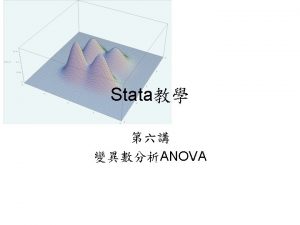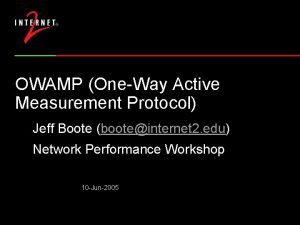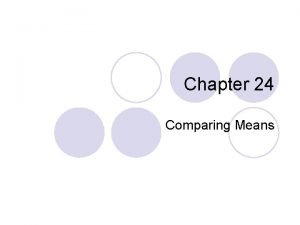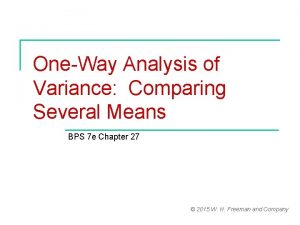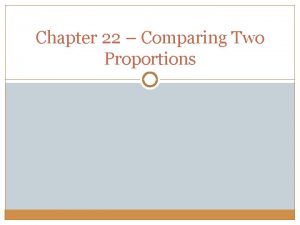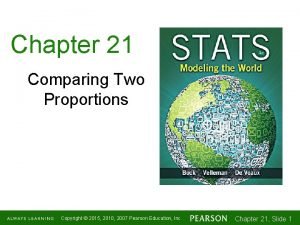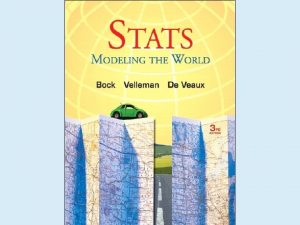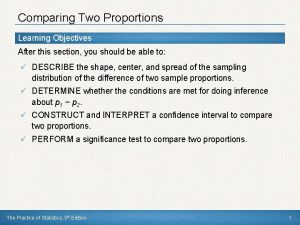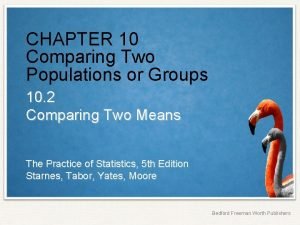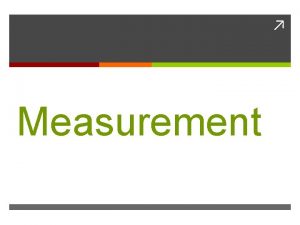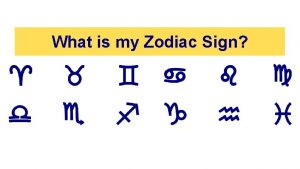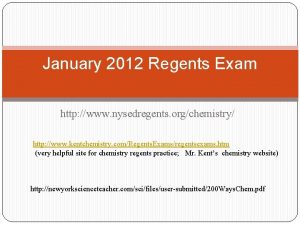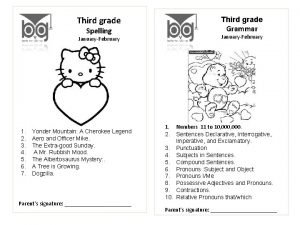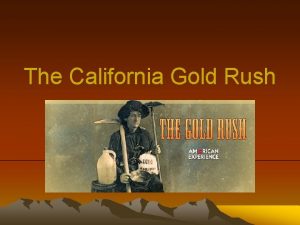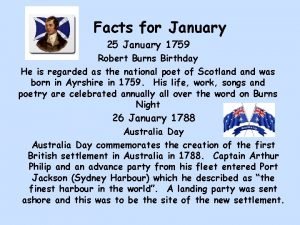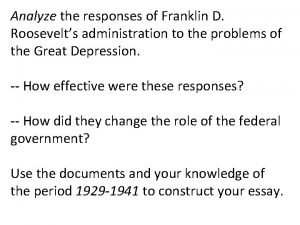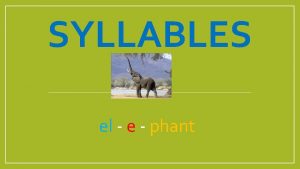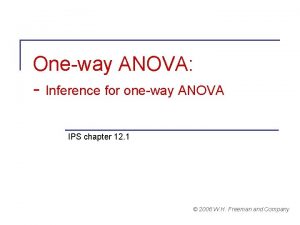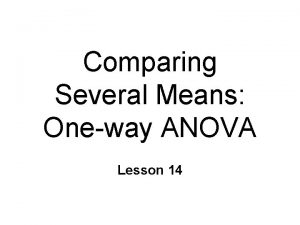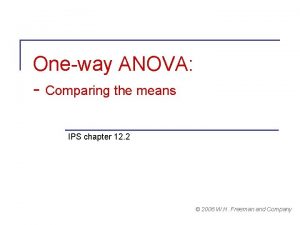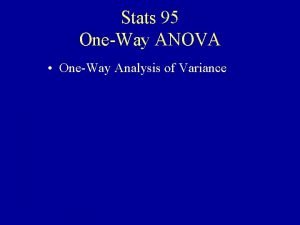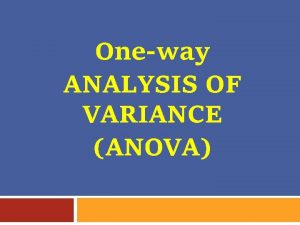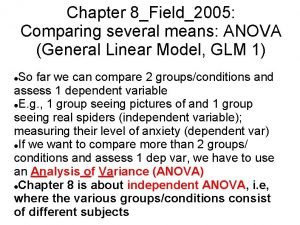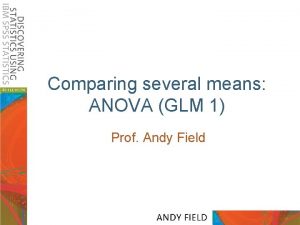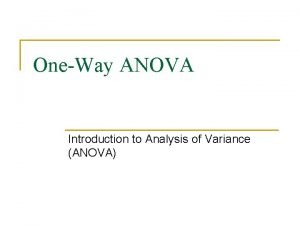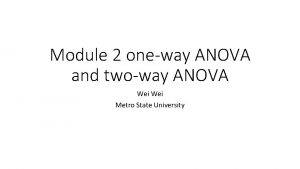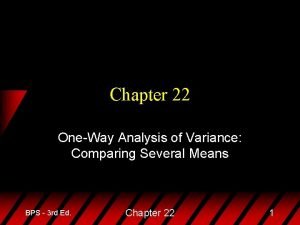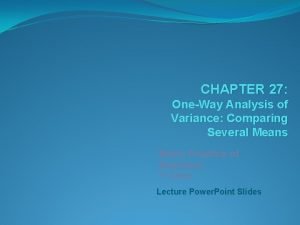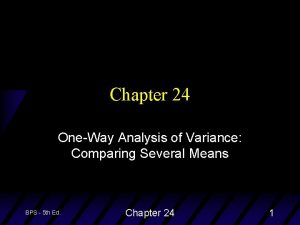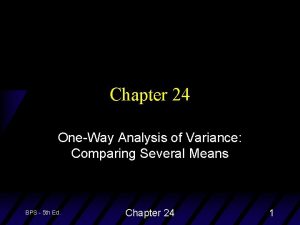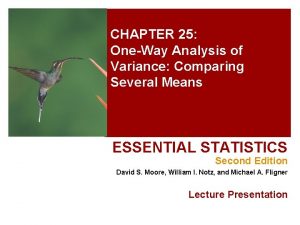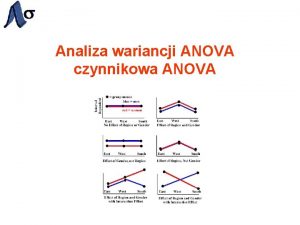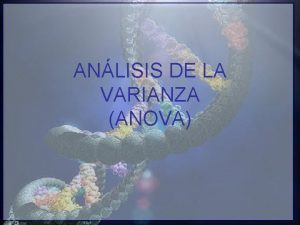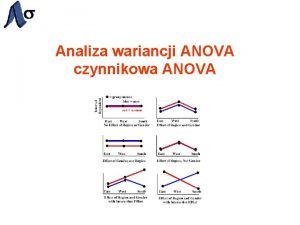Chapter 13 Comparing Several Means OneWay ANOVA January
















![Mean Square Between: Formula • Sum of Squares Between [Groups] • Degrees of Freedom Mean Square Between: Formula • Sum of Squares Between [Groups] • Degrees of Freedom](https://slidetodoc.com/presentation_image_h2/59c58a92c1a8d1e3e91a41a74920d8a4/image-17.jpg)



































- Slides: 52

Chapter 13: Comparing Several Means (One-Way ANOVA) January 22 1

In Chapter 13: 13. 1 Descriptive Statistics 13. 2 The Problem of Multiple Comparisons 13. 3 Analysis of Variance 13. 4 Post Hoc Comparisons 13. 5 The Equal Variance Assumption 13. 6 Introduction to Nonparametric Tests

Illustrative Example: Data Pets as moderators of a stress response. This chapter follows the analysis of data from a study in which heart rates (bpm) of participants were monitored after being exposed to a psychological stressor. Participants were randomized to one of three groups: • Group 1 - monitored in presence of pet dog • Group 2 - monitored in the presence of human friend • Group 3 - monitored with neither dog nor human friend present 3

Illustrative Example: Data 4

SPSS Data Table • Most computer programs require data in two columns • One column is for the explanatory variable (group) • One column is for the response variable (hrt_rate) 5

13. 1 Descriptive Statistics • Data are described and explored before moving to inferential calculations • Here are summary statistics by group: 6

Exploring Group Differences • John Tukey taught us the importance of exploratory data analysis (EDA) • EDA techniques that apply: – Stemplots – Boxplots – Dotplots John W. Tukey (1915 -2000) 7

Side-by-Side Stemplots 8

Side-by-Side Boxplots 9

§ 13. 2 The Problem of Multiple Comparisons • Consider a comparison of three groups. There are three possible t tests when considering three groups: (1) H 0: μ 1 = μ 2 versus Ha: μ 1 ≠ μ 2 (2) H 0: μ 1 = μ 3 versus Ha: μ 1 ≠ μ 3 (3) H 0: μ 2 = μ 3 versus Ha: μ 2 ≠ μ 3 • However, we do not perform separate t tests without modification → this would identify too many random differences 10

Problem of Multiple Comparisons • Family-wise error rate = probability of at least one false rejection of H 0 • Assume three null hypotheses are true: At α = 0. 05, the Pr(retain all three H 0 s) = (1− 0. 05)3 = 0. 857. Therefore, Pr(reject at least one) = 1− 0. 847 = 0. 143 this is the family-wise error rate. • The family-wise error rate is much greater than intended. This is “The Problem of Multiple Comparisons” 11

Problem of Multiple Comparisons The more comparisons you make, the greater the family-wise error rate. This table demonstrates the magnitude of the problem 12

Mitigating the Problem of Multiple Comparisons Two-step approach: 1. Test for overall significance using a technique called “Analysis of Variance” 2. Do post hoc comparison on individual groups 13

13. 3 Analysis of Variance • One-way ANalysis Of VAriance (ANOVA) – Categorical explanatory variable – Quantitative response variable – Test group means for a significant difference • Statistical hypotheses – H 0: μ 1 = μ 2 = … = μ k – Ha: at least one of the μis differ • Method: compare variability between groups to variability within groups (F statistic) 14

Analysis of Variance Overview, cont. R. A. Fisher (1890 -1962) The F in the F statistic stands for “Fisher” 15

Variability Between Groups • Variability of group means around the grand mean → provides a “signal” of group difference • Based on a statistic called the Mean Square Between (MSB) • Notation SSB ≡ sum of squares between df. B ≡ degrees of freedom between k ≡ number of groups x-bar ≡ grand mean x-bari ≡ mean of group i 16
![Mean Square Between Formula Sum of Squares Between Groups Degrees of Freedom Mean Square Between: Formula • Sum of Squares Between [Groups] • Degrees of Freedom](https://slidetodoc.com/presentation_image_h2/59c58a92c1a8d1e3e91a41a74920d8a4/image-17.jpg)
Mean Square Between: Formula • Sum of Squares Between [Groups] • Degrees of Freedom Between • Mean Square Between 17

Mean Square Between: Graphically 18

Mean Square Between: Example 19

Variability Within Groups • Variability of data points within groups → quantifies random “noise” • Based on a statistic called the Mean Square Within (MSW) • Notation SSW ≡ sum of squares within df. W ≡ degrees of freedom within N ≡ sample size, all groups combined ni ≡ sample size, group I s 2 i ≡ variance of group i 20

Mean Square Within: Formula • Mean Square Within • Sum of Squares Within • Degrees of Freedom Within 21

Mean Square Within: Graphically 22

Mean Square Within: Example 23

The F statistic and ANOVA table • Data are arranged to form an ANOVA table • F statistic is the ratio of the MSB to MSW Fstat “signal-to -noise” ratio 24

Fstat and P-value • The Fstat has numerator and denominator degrees of freedom: df 1 and df 2 respectively (corresponding to df. B and df. W) • Convert Fstat to P-value with a computer program or Table D • The P-value corresponds to the area in the right tail beyond 25

Table D (“F Table”) • The F table has limited listings for df 2. • You often must round-down to the next available df 2 (rounding down preferable for conservative estimate). • Wedge the Fstat between listing to find the approximate P-value df 1 = 2, df 2 = 42 (Table D does not have df 2 of 42; next lowest df 2 is 30). Fstat = 14. 02 falls below P of 0. 001 26

Fstat and P-value P < 0. 001 27

ANOVA Example (Summary) A. Hypotheses: H 0: μ 1 = μ 2 = μ 3 vs. Ha: at least one of the μis differ B. Statistics: Fstat = 14. 08 with 2 and 42 degrees of freedom C. P-value =. 000021 (via SPSS), providing highly significant evidence against the H 0; conclude the heart rates (an indicator of the effects of stress) differed in the groups D. Significance level (optional): Results are significantly at α =. 00005 28

Computation Because of the complexity of computations, ANOVA statistics are often calculated by computer 29

ANOVA and the t test (Optional) ANOVA for two groups is equivalent to the equal variance (pooled) t test (§ 12. 4) • Both address H 0: μ 1 = μ 2 • df. W = df for t test = N – 2 • MSW = s 2 pooled • Fstat = (tstat)2 • F 1, df 2, α = (tdf, 1 -α/2)2 30

13. 4 Post Hoc Comparisons • ANOVA Ha says “at least one population mean differs” but does not delineate which differ. • Post hoc comparisons are pursued after rejection of the ANOVA H 0 to delineate differences 31

SPSS Post Hoc Comparison Procedures Many post hoc comparison procedures exist. We cover the LSD and Bonferroni methods. 32

Least Squares Difference Procedure Do after a significant ANOVA to protect against the problem of multiple comparisons A. Hypotheses. H 0: μi = μj vs. Ha: μi ≠ μj for each group i and j B. Test statistic C. D. C. P-value. Use t table or software 33

LSD Procedure: Example For the “pets” illustrative data, we test H 0: μ 1 = μ 2 by hand. The other tests will be done by computer A. Hypotheses. H 0: μ 1 = μ 2 against Ha: μ 1 ≠ μ 2 B. Test statistic. C. P-value. P = 0. 0000039; highly significant evidence of a difference. 34

LSD Procedure, SPSS Results for illustrative “pets” data. H 0: μ 1 = μ 2 H 0: μ 1 = μ 3 H 0: μ 2 = μ 3 35

95% Confidence Interval, Mean Difference, LSD Method 36

95% CI, LSD Method, Example Comparing Group 1 to Group 2: 37

Bonferroni Procedure The Bonferroni procedure is instituted by multiplying the P-value from the LSD procedure by the number of post hoc comparisons “c”. A. Hypotheses. H 0: μ 1 = μ 2 against Ha: μ 1 ≠ μ 2 B. Test statistic. Same as for the LSD method. C. P-value. The LSD method produced P =. 0000039 (two-tailed). Since there were three post hoc comparisons, PBonf = 3 ×. 0000039 =. 000012. 38

Bonferroni Confidence Interval Let c represent the number of post hoc comparisons. Comparing Group 1 to Group 2: 39

Bonferroni Procedure, SPSS P-values from Bonferroni are higher and confidence intervals are broader than LSD method, reflecting its conservative approach 40

§ 13. 5. The Equal Variance Assumption • Conditions for ANOVA: 1. Sampling independence 2. Normal sampling distributions of mean 3. Equal variance within population groups • Let us focus on condition 3, since conditions 1 and 2 are covered elsewhere. • Equal variance is called homoscedasticity. (Unequal variance = heteroscedasticity). • Homoscedasticity allows us to pool group variances to form the MSW 41

Assessing “Equal Variance” 1. Graphical exploration. Compare spreads visually with side-by-side plots. 2. Descriptive statistics. If a group’s standard deviation is more than twice that of another, be alerted to possible heteroscedasticity 3. Test variances. A statistical test can be applied (next slide). 42

Levene’s Test of Variances A. Hypotheses. H 0: σ 21 = σ 22 = … = σ 2 k Ha: at least one σ2 i differs B. Test statistic. Test is performed by computer. The test statistic is a particular type of Fstat based on the rank transformed deviations (see p. 283 for details). C. P-value. The Fstat is converted to a P-value by the computational program. Interpretation of P is routine small P evidence against H 0, suggesting heteroscedasticity. 43

Levene’s Test – Example (“pets” data) A. H 0: σ21 = σ22 = σ23 versus Ha: at least one σ2 i differs B. SPSS output (below). Fstat = 0. 059 with 2 and 42 df C. P = 0. 943. Very weak evidence against H 0 retain assumption of homoscedasticity 44

Analyzing Groups with Unequal Variance • Stay descriptive. Use summary statistics and EDA methods to compare groups. • Remove outliers, if appropriate (p. 287). • Mathematically transform the data to compensate for heteroscedasticity (e. g. , a long right tail can be pulled in with a log transform). • Use robust non-parametric methods. 45

13. 6 Intro to Nonparametric Methods Many nonparametric procedures are based on rank transformed data (“rank tests”). Here are examples: 46

The Kruskal-Wallis Test • Let us explore the Kruskal-Wallis test as an example of a non-parametric test • The Kruskal-Wallis test is the nonparametric analogue of one-way ANOVA. • It does not require Normality or Equal Variance conditions for inference. • It is based on rank transformed data and seeing if the mean ranks in groups differ significantly. 47

Kruskal-Wallis Test • The K-W hypothesis can be stated in terms of mean or median (depending on assumptions made about population shapes). Let us use the later. • Let Mi ≡ the median of population i • There are k groups • H 0 : M 1 = M 2 = … = Mk • Ha: at least one Mi differs 48

Kruskal-Wallis, Example Alcohol and income. Data from a survey on alcohol consumption and income are presented. 49

Kruskal-Wallis Test, Example We wish to test whether the means differ significantly but find graphical and hypothesis testing evidence that the population variances are unequal. 50

Kruskal-Wallis Test, Example, cont. A. Hypotheses. H 0 : M 1 = M 2 = M 3 = M 4 = M 5 vs. Ha: at least one Mi differs B. Test statistic. Some computer programs use chi-square statistic based upon a Normal approximation. SPSS derives Chi-square statistics = 7. 793 with 4 df (next slide) 51

Kruskal-Wallis Test, Example, cont. P = 0. 099, providing marginally significant evidence against H 0. 52
 Stata oneway
Stata oneway Owamp
Owamp Oneway hash
Oneway hash Perbedaan two way anova dan one way anova
Perbedaan two way anova dan one way anova One way anova vs two way anova
One way anova vs two way anova Klasifikasi anova
Klasifikasi anova Chapter 24 comparing means
Chapter 24 comparing means Resting pulse rates for a random sample of 26
Resting pulse rates for a random sample of 26 Several means
Several means Comparing means in excel
Comparing means in excel Chapter 22 comparing two proportions
Chapter 22 comparing two proportions Chapter 10 comparing two populations or groups crossword
Chapter 10 comparing two populations or groups crossword Chapter 21 comparing two proportions
Chapter 21 comparing two proportions Understanding and comparing distributions
Understanding and comparing distributions Chapter 22 comparing two proportions
Chapter 22 comparing two proportions Chapter 22 comparing two proportions
Chapter 22 comparing two proportions Chapter 22 comparing two proportions
Chapter 22 comparing two proportions Chapter 10 comparing two populations or groups
Chapter 10 comparing two populations or groups Poly and gon
Poly and gon Morphe means in metamorphism
Morphe means in metamorphism Meta and morph means
Meta and morph means In situ conservation
In situ conservation Life bio
Life bio Mozart nationality
Mozart nationality Zodiac for january 20
Zodiac for january 20 Newton biography
Newton biography March april may season
March april may season January february march
January february march January 2006 chemistry regents answers
January 2006 chemistry regents answers January 2012 chemistry regents
January 2012 chemistry regents Nysedregents chemistry
Nysedregents chemistry January starts the year poem risa jordan
January starts the year poem risa jordan Ib history ia grade boundaries
Ib history ia grade boundaries January character trait
January character trait January 2006 calendar
January 2006 calendar January 27 1756
January 27 1756 When was mozart born and died
When was mozart born and died January february spelling
January february spelling What is the theme for the month of january
What is the theme for the month of january Beetlejuice planet size
Beetlejuice planet size January 24 1848
January 24 1848 William lloyd garrison jr new deal
William lloyd garrison jr new deal 1995 january 23 nasa
1995 january 23 nasa 25 january 1759
25 january 1759 An asset was purchased for $120 000 on january 1
An asset was purchased for $120 000 on january 1 Meridel lesueur, new masses, january 1932.
Meridel lesueur, new masses, january 1932. 1st january 2018
1st january 2018 How many syllables in helicopter
How many syllables in helicopter Movies with january in the title
Movies with january in the title Manage end user devices
Manage end user devices January comes before
January comes before January 19, 1809
January 19, 1809 When was edgar allan poe born
When was edgar allan poe born
